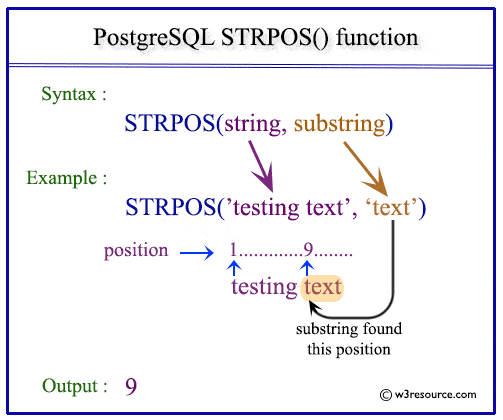PostgreSQL STRPOS() function
STRPOS() function
The PostgreSQL strpos() function is used to find the position, from where the substring is being matched within the string.
Uses of STRPOS() Function
- Finding Substring Position: Locate the starting position of a substring within a string.
- String Analysis: Determine the occurrence of specific patterns or substrings.
- Conditional Queries: Filter rows based on the presence of a substring within a column.
- Data Validation: Check for the presence and position of required substrings in data fields.
- Substring Counting: Identify multiple occurrences and their positions within a string.
Syntax:
strpos(<string>, < substring >)
PostgreSQL Version: 9.3
Visual Presentation of PostgreSQL STRPOS() function
Example of PostgreSQL STRPOS() function:
In the example below, the position of the specified substring 'so' within the string as specified in the first parameter within the argument is 5.
SQL Code:
SELECT strpos('w3resource', 'so')AS "Position of substring";
Output:
Position of substring
-----------------------
5
(1 row)
Example of PostgreSQL STRPOS() function using column:
Sample Table: employees
If we want to display the employee_id, first_name, last_name and the position of a specific substring 'lia', which must exists within the column first_name from employees table, the following SQL can be used.
SQL Code:
SELECT employee_id,first_name,last_name,
strpos(first_name,'lia') AS "Position of lia"
FROM employees
WHERE strpos(first_name,'lia')>0;
Output:
employee_id | first_name | last_name | Position of lia
-------------+------------+-----------+-----------------
125 | Julia | Nayer | 3
171 | William | Smith | 4
186 | Julia | Dellinger | 3
206 | William | Gietz | 4
(4 rows)
Previous: SPLIT_PART function
Next: SUBSTR function

